You hip is a complicated joint with 5 bones, 17 muscles, numerous tendons, ligaments and bursae connecting your leg bone (femur), pelvis and spine all together. The iliopsoas muscle is actually made up of two separate muscles located in front of the hip. These muscles and tendons connect the pelvis to large leg bone (femur), and are often called the 'hip flexors'. They help with movements of the hip and leg to to pull the knee upward, help us stand, sit and lay down.
If you are suffering from hip flexor tendonitis (Iliopsoas Tendonitis) it might be hard to tell as pain can often manifest in other areas of the hip, thigh, lower back or buttock. Sometimes pain can even shoot down the inside of your thigh or even down the front of your leg to your knee. If left untreated, hip flexor tendonitis can turn into a chronic condition or degeneration of your tendon fibers.
Hip tendonitis (tendinitis) is a condition where you experience pain, swelling and inflammation from damage or micro-tearing of one or more of the tendons in your hip. The tendons in your hip connect muscle to bone and when these tendons are injured they usually cause pain and tenderness at the front, side and back of your hip, and even into your buttocks as well.
Anyone can suffer from tendinitis, but it's most common in adults due to degeneration of tissue as we age. Over time the tendons in the hip will wear down resulting in something called degeneration. This is where the fibers in your tendons will become more weak - it's just a natural process that happens as we age.
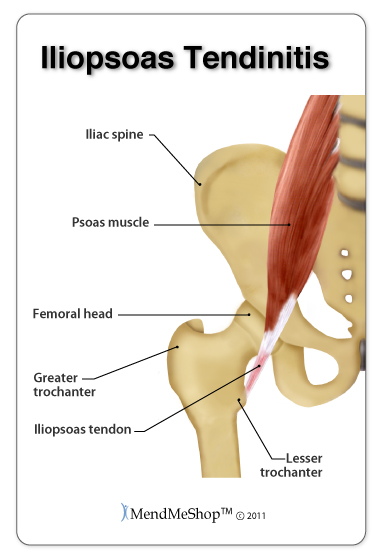
If you have iliopsoas tendinitis you may experience pain and tenderness that slowly increases over time in the front of your hip and groin. Pain may increase after activities like jogging, running or kicking. As the condition progresses you may notice pain when putting on socks and shoes, rising from a seated position, walking upstairs or brisk walking. You may also notice radiating pain from the front of the thigh toward the knee. On occasion you may have lower back pain. Typically, the amount of time between first on-set symptoms and a proper diagnosis of iliopsoas tendonitis is approximately 32 to 41 months.
Hip tendonitis is an overuse / repetitive use injury of the hip area, resulting in damage or micro-tearing to the tendon tissue. The tendon becomes inflammation and swollen. Activities that may causes Hip tendonitis include:
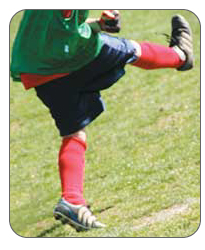
The best way to diagnose this condition is with a quick visit to the your doctor or physical therapist for a physical examination of your hip and groin area. A doctor or physical therapist may perform a Ludloff test, which requires you to sit with your knees extended and elevate your heel on the side you have pain. This movement of the hip and groin will help your doctor to see if you have any weakness around your hip flexor. They may also be able to see if you have any related hip injuries or conditions like snapping hip syndrome. An MRI may be ordered to pin-point the location of your tendonitis allowing you to know where you need to apply treatment for healing.
Pain, swelling and inflammation in your hip could mean that you have hip tendonitis. It's also important to consider that there are other conditions that might cause pain in your hip as well. With so many connections of tissue to the bone it's easy to see why any pain in the hip can be tendonitis or some other injury in the same area. You may even have tendonitis AND another hip condition at the same time. The only way you can know for sure whether you have hip tendonitis is if you get a proper diagnosis for the condition by your doctor. Some other hip injuries include: hip tendonitis, snapping hip syndrome, greater trochanteric pain syndrome, hip arthritis, labral tear, osteonecrosis, or a fractured hip.
Inflammation and pain of the bursa sac in the hip joint. Pain and tenderness is found deep in your groin and radiates around to the front of your hip or upper thigh area, and can follow the length of the tendon down toward your knee; it will often move into your lower back and buttock area as well.
Hip Bursitis is common during growth spurts when you are younger because your biomechanics are altered around the hip area. The tendons and muscles area tight, the pelvis begins to tilt, and the rest of the lower body goes out of alignment. This can affect the lower back, hip joints, knees and your gait which can result in lower body joint issues.
Rheumatoid arthritis or gout can cause iliopsoas bursitis. Some people with diseases such as rheumatoid arthritis, gout or scleroderma may contract bursitis from crystalline deposits in the joints. Although not much is known about how this process happens, it is common knowledge that uric acid is a normal byproduct of daily metabolism. If you have gout, you are unable to break down this uric acid properly, leading to crystallization of this excess acid which deposits in joints. This can cause joint pain that can often lead to bursitis.
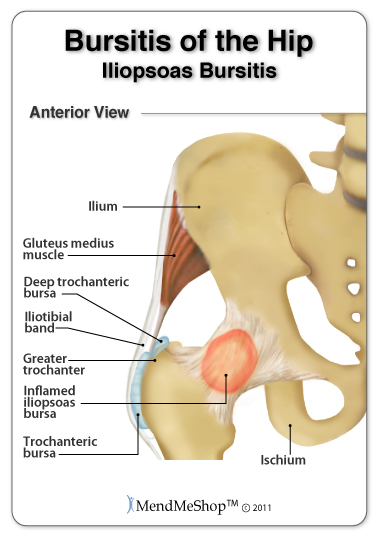
Iliopsoas bursitis and iliopsoas tendonitis are often caused by excessive rubbing against a broad, shallow groove over which your iliacus and psoas major pass (the pubic iliopectineal eminence). The tendon may first become irritated and inflamed, leading to swelling and increase friction on the iliopsoas bursa underneath.
If you one leg that is shorter than the other, this may result in a skewed gait (abnormalities in the way you walk) which can cause more pressure on the iliopsoas bursa than usual. In addition, age and the degeneration of soft tissues can often cause a decrease in your tendon flexibility, which in turn can change the movement mechanics in your hip joint. A change in movement mechanics generally cause excess friction on certain tendons and bursae.
Snapping hip syndrome is when you feel a snapping sensation or hear a popping sound in your hip when you walk, get up from a chair or swing you leg around. This feeling and/or sound is made by a tendon in your hip as it moves over a bony bump. Most of the time this is more annoying than painful. However long-term snapping/popping can lead to hip bursitis, a condition that is very painful.
GTPS causes chronic pain on the side of the hip. Symptoms of GTPS include constant pain in the side hip that travels along the whole side of the thigh to the knee and occasionally below the knee and/or buttock. If you have this condition you will probably feel very specific point tenderness on the side of the hip.
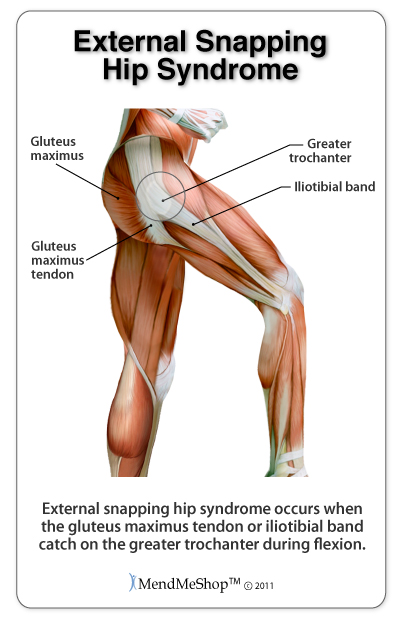
Joint pain in the hip is often described as a dull aching pain in the groin, outer thigh, or buttocks. You may feel more pain in the morning that could get worse as the day goes but generally lessens as you get more active. Doing anything vigorous can result in pain, stiffness and may limit your movements or make walking difficult. Arthritis means inflammation of a joint and there are a number of types of arthritis of the hip - including:
The labrum is the cartilage that surrounds the hip joint. If you have a tear in your labrum you may feel a catching sensation and pain in the hip joint, groin, stiffness and limited range of motion of your hip. Any changes or abnormalities in the physical structure of the hip can lead to a tear in the labrum cartilage.
Osteonecrosis is a disease that affects blood flow to an area of bone. This lack of blood flow to the bone in the hip joint causes tissue to die and the bone may eventually collapse. Osteonecrosis is a condition that develops in stages, general hip pain is usually felt first that may progress to a dull ache or throbbing pain in the groin or buttock area. If you have this condition you may also have more pain and find it difficult to stand and put weight on you hip. Moving your hip joint will also be painful. These stages can last anywhere from several months to over a year. Early diagnosis of this disease provides a much better outcome with consistent, proper treatment.
De-generative hip fractures are most common in elderly patients with osteoporosis. Treatment of broken hips requires surgery to either replace the broken portion or repair it with a metal plate and screws. Stress fractures of the hip are most common in athletes who participate in high-impact sports, such as long distance runners. Treatment is usually successful as long as the patient avoids activity that would result in an impact to the hip.
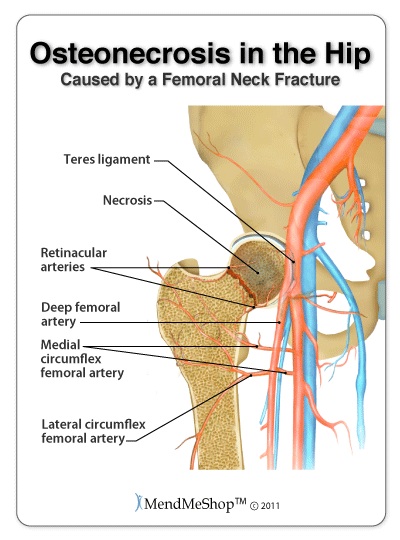
No one is immune to tendinitis, you can reduce your risk of re-injury with consistent conservative treatments
If you have pain and inflammation in your hip, buttock and/or your tail bone, it's very important to heal your injury quickly and completely. You must avoid the build up of scar tissue. If you don't, your hip tendinitis injury may last for a very long time. This is why it's so important to continuously use conservative treatment tools to heal any recurring tendon damage before it can build into something big. For any hip tendinitis sufferer, having the right tools makes all the difference.
In mild and moderate cases of tendinitis / strained tendons, your PT will most likely encourage you to augment your sessions with conservative home exercises/treatments. Severe injury to the tendon (ruptured tendons) will require surgery to re-attach the tendon to your bone or bring the edges of the tear together. If you suspect that you've ruptured your tendon be sure to speak with your doctor for suggested treatment.
The first step for conservative treatment of your hip tendinitis is to reduce the swelling to "open up" the area for more blood flow. Anyone in the health-care business knows that your blood supplies the oxygen and much needed nutrients required to heal hip tendinitis injuries. This is why for years, doctors, trainers, and other medical professionals have recommended RICE (Rest, Ice, Compression, Elevation) to treat the pain and swelling of fresh injuries, chronic pain, and after any re-injury.
This is important because once blood vessels are blocked or damaged, they can no longer carry oxygenated blood to your damaged tendon and tissues begin to break-down. Without cold compression, tissues break down further because they can't get the oxygen they need to survive. By limiting the amount of damage done to your tendons, you also limit the amount of healing that needs to occur. This is a very important step to heal acute or chronic tendon injuries faster and with less pain.
After the inflammation in your hip has been reduced, providing extra blood flow and strengthening soft tissue in the injured area is recommended.
TShellz Wraps® contain a unique Carbon Fiber Energy Pad which is flexible and will shape to conform to your body. This Energy Pad emits a uniform wave of perfectly safe energy over its entire surface. This energy is absorbed by soft tissue in the treatment area, opening blood vessels, resulting in an increase in blood flow. Increased blood circulation is what your body needs to accelerate the healing of soft tissue and this is why we recommend the TShellz Wrap®.
The TShellz Wrap® is an FDA Registered Medical Device and is suitable for use in therapeutic clinics and FROM HOME. It is completely safe for people and patients to use for themselves.
The technology found in a TShellz Wrap® has been used for decades in the worlds of professional and amateur sports - a contributing factor as to why athletes seem to recover from injuries so quickly.
Have you ever wondered by an athlete can return to activity after 3 or 4 weeks following a soft tissue injury - while your average person takes much longer to return back to normal? The secret isn't really that much of a secret - it involves consistent treatments (meaning multiple times a day) using a treatment like the TShellz Wrap® to stimulate blood flow to the injured tissues. Most athletes have the luxury of using in-house facilities many times per day.
How many us can afford the time and money to visit a clinic multiple times a day? Very few indeed. This is how you can gain some of the advantages that athletes enjoy in their injury recovery - by using a device like the TShellz Wrap® two or three times a day on a consistent basis.
We believe the TShellz Wrap® to be one of the most effective home treatments to increase localized blood flow in and around the treatment area.
We can promise that you will receive a product that is designed to be safe and does what it is supposed to do... reduce pain (as stated in "Therapeutic Heat and Cold", 4th edition. - Ed. Justus F. Lehmann, M.D., Williams, and Wilkin) temporarily increase length & flexibility of soft tissue (as stated in "Therapeutic Heat and Cold", 4th edition. - Ed. Justus F. Lehmann, M.D., Williams, and Wilkin) and aid your body in recovering from tendon, muscle and other soft tissue injuries via enhanced blood flow.
The unit plugs into a standard wall outlet to get its power. The nice thing about the power supply is that the same unit can be used in North America and overseas as well. It has the capability to operate between 110v and 230v.
The TShellz Wrap® has a special signal controller that can be set for 3 different power levels of application (3=High, 2=Medium, 1=Low). The cord is long enough that you can sit or lie comfortably and watch TV, read or surf the net while you're using it.
Treatments are max 30 minutes in duration and the device can be worn over clothing. This allows you to use the device at work, at home, or really anywhere you have access to an electrical outlet.
The most common question we receive from individuals prior to purchasing is - how many times a day should I be using my wrap and when should I be using them? While treatment plans will differ for each individual and their specific injury, there are general guidelines that should be adhered to.
The TShellz Wrap® would then be used:
Conservative treatment tools just like these have been used successfully by thousands of soft tissue injury sufferers - just like you.
We believe the use of TShellz® Circulatory Boost Wraps for boosting blood flow to soft tissue in the area of application is one of the most under-utilized home treatment options available on the market today. We have client after client that have tried many options out there and have been amazed at how effective and fast the TShellz Wrap treatment can relieve pain and increase blood flow in the treatment area.
With regular use of the TShellz® Circulatory Boost Wrap:
*Know that every personal soft tissue injury is unique and the TShellz Wrap may not work for everyone. This is why we offer a 60-day money back return on all our TShellz Wrap devices.
We all know that if the injury was healed, the pain would go away but what about the opposite situation? If the pain is gone, does that mean the injury is better? Unfortunately, this is not always true.
Too many people only focus on suppressing pain symptoms while providing less attention to the true healing aspects of the body. Experiencing less pain, while obviously a good short-term goal, does not equate to underlying healing. Scar tissue can remain for months after one gets to a point of being relatively pain-free. However, as long the weak and brittle scar tissue remains, you are susceptible to re-injury or re-aggravation. Certain motions or movements can cause the weaker tissue to easily tear - resulting in some reversal of the recovery up until that point.
This is why we recommend for people to continue with their doctor or therapist recommended exercises and to continue with mild treatments of the TShellz Wrap® for a period of time - to better ensure complete recovery.
Ongoing treatments to enhance circulation are intended to soothe, relax and promote healing of damaged soft tissue in the application area. T•Shellz treatment also results in the ability of soft tissue to extend further due to the effect of heat on soft tissue. The more extensible your tissues are, the less likely they are to strain or sprain.
People tell us all the time, "I was told that if I stay off my feet for a few weeks, my pain will disappear for good."
The truth is, tendonitis pain is usually a culmination of numerous factors, such as repetitive stress, poor posture, acute injuries, and overcompensation issues resulting from other muscle and soft tissue ailments.
It may take weeks or months for these pain triggers to surface. When they , however, merely resting will solve the underlying issues. You need to utilize actions and options that actually treat the source of the pain and help reverse the damage that has been done.
Resting has a role to play, but it is only one small factor in a recovery plan.
Product Advisors are available 9:00 am to 5:00 pm Eastern Standard Time Monday to Friday.
I want to learn more about Post-Surgery Recovery
I want to learn more about TShellz Wrap® Circulatory Boost
I want to learn more about Ice & Heat: Which Is Better For Treatment?
I want to learn more about Tendonitis Treatments
I want to learn more about Tendonitis Surgery
During your recovery, you will probably have to modify and/or eliminate any activities that cause pain or discomfort at the location of your soft tissue injury until the pain and inflammation settle. The more diligent you are with your treatment and rehabilitation, the faster you will see successful results!
Please be aware that this information is neither intended nor implied to be a substitute for professional medical advice. CALL YOUR HEALTHCARE PROVIDER IMMEDIATELY IF YOU THINK YOU MAY HAVE A MEDICAL EMERGENCY. Always seek the advice of your physician or other qualified health provider before using any of our outstanding products to make sure they are right for you and your condition or if you have any questions regarding a medical condition. Always see your doctor for a proper diagnosis as there are often many injuries and conditions (some very serious) that could be the cause of your pain.
© 2025 In.Genu Design Group, Inc. Contact Us